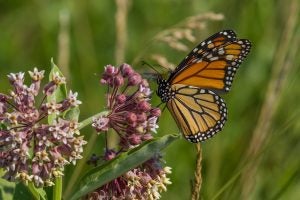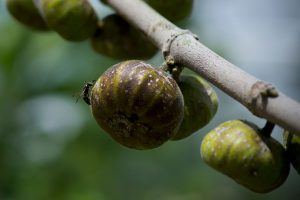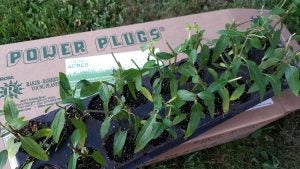Honeybees are a well-known source of pollination, with the added bonus of having honey to harvest at the end of, and sometimes even throughout, the growing season. But even with the added benefit of collecting honey, honeybees aren’t necessarily the best pollinators.
In the 1980s, the Varroa mite was introduced to domestically managed honeybee colonies, which resulted in a sharp decline in honeybee colonies across the nation. In 2006, Colony Collapse Disorder (CCD) was first recorded, with a devastating loss that year of around 31 percent of managed honeybee colonies nationwide.
Aside from all this, honeybees are extremely discerning in their choice of food sources. For example, tomatoes are never pollinated by honeybees due to the small size of their flowers and the buzz-pollination required to achieve success in pollination. Tomatoes also do not have nectar to feed honeybees. On the flipside, almond crops are exclusively pollinated by honeybees, but the logistics that come with that are challenging. Almond producers require beekeepers to travel with their hives to fulfill pollination contracts nationwide.
Related: Perspective: Maybe we could get by without bees, but why take that chance?
Other pollinators include butterflies (like the monarch), and moths, flies, wasps, beetles, bats, birds, and other small animals. A 2015 Pollinator Health Strategy report tells us that there has been a roughly 90 percent decline in monarch butterfly populations.
Although not as extreme, there have been declines in pollinator populations across the board, insect or otherwise. So what’s going on?
Even as modern agricultural insecticides have become more targeted and used discerningly, the use of agricultural pesticides has had a negative impact on population numbers. The encroachment of humans on natural habitats is another major cause of the population losses in pollinating insects. The removal of vegetation from these areas takes away shelter and food sources for insects.

This is particularly bad news for insects that do not have a varied diet or are not particularly efficient foragers. For example, the larvae of the monarch butterfly live exclusively on milkweed and relies on it for food and shelter. The Pollinator Health Strategy report identifies the “loss of milkweed breeding habitat in corn and soybean production, loss of breeding habitat due to land conversion, illegal logging and deforestation at overwintering sites, and extreme weather conditions,” along with other issues like disease, predators, parasites, and insecticides as the causes of population loss of monarch populations.
It’s why many conservation efforts in the production-centric Midwest focus on better-utilizing buffer zones and creating pockets of pollinator habitats around farms and highways.

A 2016 study showed the importance of non-bee insects as pollinators in nearly every cropping system. In fact, there are many crops that rely exclusively on pollination by a non-bee insect.
Figs and fig wasps evolved to have a symbiotic and mutually exclusive relationship where the female fig wasp pollinates the flowers of the fig tree in the process of laying her eggs. Then the eggs hatch, males tunnel the females out after fertilizing them, and as the female wasps climb out, they pick up pollen, fly away, and find another fig tree on which to repeat the process. Native or non-honeybees, like mason bees, are generally smaller than honeybees and are even more effective pollinators. The hoverfly, whose appearance mimics a bee and a fly, can be even more effective pollinators than bees due to their tendency to wander a much larger area, pollinating along the way.
With the increasing threats to a variety of honeybee populations, what can be done to support pollinator populations?
Many agricultural certifications, like biodynamic certification by Demeter International, require a percentage of land to be set aside as a reserve for natural habitat to house and feed native insects and animals. Creating safe havens like this can help to increase the populations of insects that support pollination.

Here are a few more ideas:
- Planting plenty of flowers interest and beauty to your garden or crop rows. Bonus points if they are milkweed and/or native plants. Don’t know where to start? Some agricultural companies will send out free packages of pollinating plants (like BASF has done), or you can check out your local conservation district or university extension office.
- You can keep honeybees or, better yet, provide bee houses for native bees that live solitary lives rather than living in colonies like honeybees. These look similar to bird houses with paper straws stacked inside.
- Consider installing a bat house or two for your nocturnal pollinators.
- Keeping water available for pollinators in bird baths or some other vessel also supports these important insects.
With many food sources heavily relying on pollination, it’s up to all of us as consumers to contribute to the improvement of pollinator populations. Agricultural producers can consider dedicating part of their land as a natural preserve or interplanting pollinator-attracting plants in their crop rows like milkweed or various herbs. If you can do anything else, tell your friends!
Farm on.
Brianna Scott is a veteran farmer who lives in Eastern Washington while earning her Master’s of Science in Agriculture from Washington State University. She is active in the veteran ag community and raises poultry and livestock while growing a large market garden.



